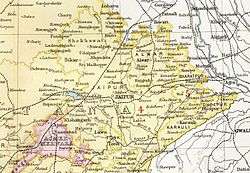Lawa Thikana
Lawa Thikana was a Thikana estate or Thakurat under the Jaipur Residency of the former Rajputana Agency.[1] It was located very close to Tonk town and included its capital, Lawa, a small town and its surroundings. Lawa is located in the northwestern part of present-day Tonk district of Rajasthan, India. Lawa estate near Tonk should not be confused with Sardargarh, a Thikana of Udaipur State (Mewar) which had been known as 'Lawa' before 1738.[2][3]
| Lawa State लावा | |||||||||
|---|---|---|---|---|---|---|---|---|---|
| Princely State of British India | |||||||||
| 1772–1947 | |||||||||
 Lawa State in the Imperial Gazetteer of India | |||||||||
| Capital | Lawa | ||||||||
| Area | |||||||||
• 1901 | 49 km2 (19 sq mi) | ||||||||
| Population | |||||||||
• 1901 | 2671 | ||||||||
| • Type | Principality | ||||||||
| History | |||||||||
• Established | 1772 | ||||||||
• Acceded to India | 1947 | ||||||||
| |||||||||
| Today part of | Rajasthan, India | ||||||||
History
Lawa was formerly part of Jaipur State. In 1772 Lawa became a jagir which came under the control of the Marathas through Pindari leader Amir Khan, who would later become the Nawab of Tonk. Lawa became a tributary of Tonk in 1817, when that state was established.[1]
In 1867 following the murder of the uncle of the ruler of Lawa together with a party of his followers, Lawa was declared a separate Chiefship under the protection of the British Government.[4]
Lawa was one of the Thikanas which were existing at the time of the independence of India and were merged with Rajasthan during the Unification of Rajasthan.